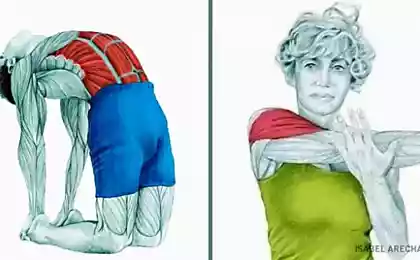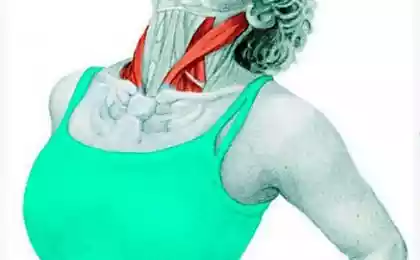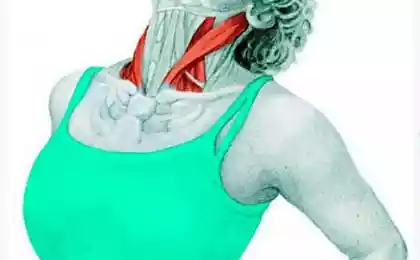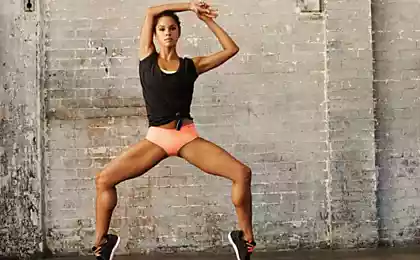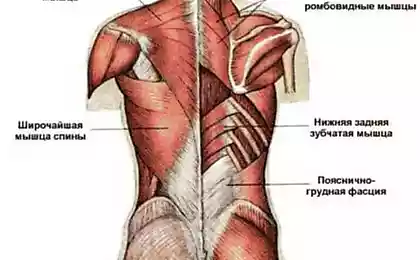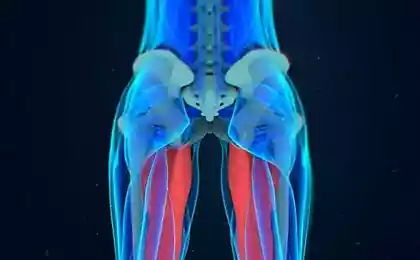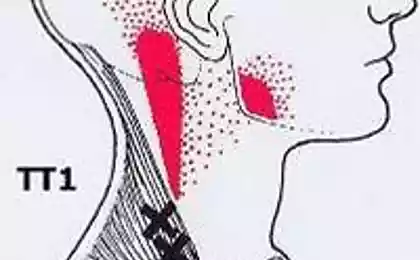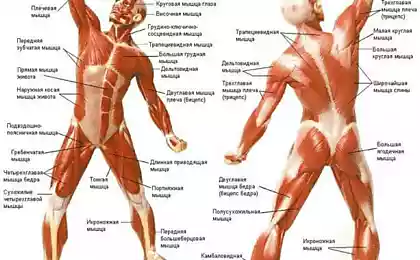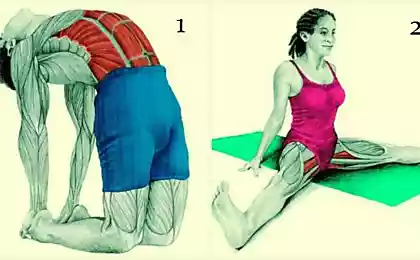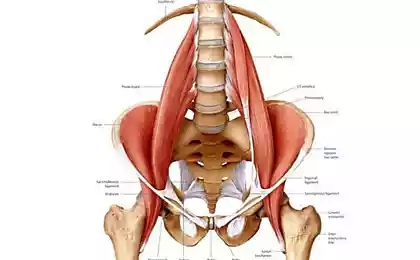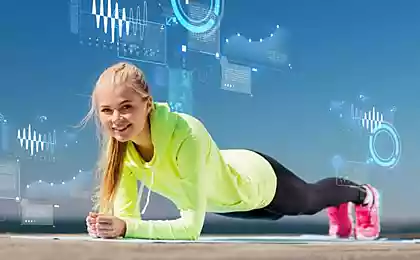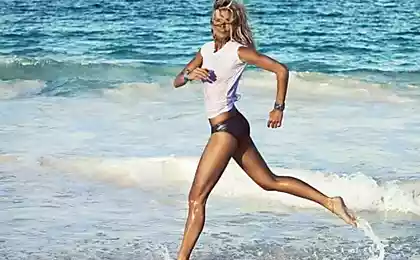1216
Moral muscle: the adductor muscles of the thigh
Today we talk about a group of adductor muscles of the thigh (adductor thigh). Very often, these muscles are ignored which can lead to some problems. These muscles are located on the inner side of the thigh and form the basic layer of muscle.
They tighten the legs to the midline of the body. The adductor muscles of the thigh is a group of several long muscles that form the inner thighs. This group includes: a thin muscle, long, short and great adductor muscles, ridged muscle.
Ninety eight million three hundred ninety seven thousand one hundred sixty one
Anatomy.
This group includes: thin muscle, long, short and great adductor muscles, ridged muscle.
Seventy seven million eighty nine thousand sixty one
The adductor muscles of the thigh are attached as follows:
All the muscles of the medial (inner) thigh muscles perform the same function: adduction of the thigh and rotating it outwards (supination).
Sixty two million seven hundred sixty eight thousand eight hundred one
In addition to their primary function, which consists in bringing the thigh, these muscles are to some extent involved in the flexion-extension in the hip joint and axial rotation of the limb.
Their role in the implementation of the flexion and extension (Fig. 149, inside view) depends on the location of their attachment. Muscles originating posterior to the frontal plane passing through the center of the joint (line of dots and dashes) provide the extension, especially the lower fibres of the great adductor muscles (i.e. the "third adductor") and, of course, this function involves the sciatic-femoral muscles.
If adductor begin anteriorly from the frontal plane, they provide flexion. In this function, the muscle involved comb, short and long adductor, the upper fibers of the large adductor muscles and thin muscle. However, you should pay attention to the fact that their role in the implementation of flexion and extension depends on the initial position of the hip joint.
The adductor muscles, as mentioned earlier, provide stabilization of the pelvis by relying on both limbs, thus they play a critical role in the adoption of certain postures and movements in sport (ski, Fig.150, horseback riding, Fig.151).
Eighty eight million seven hundred forty eight thousand seven hundred eighty
The main problems with the adductor muscles.
1. Posture (stability of the pelvis, weakening the press and the gluteal muscles, the "front" position of the pelvis)
2. Gait (duck walk, perevalivanie from foot to foot)
3. Reduction of flexibility (problems with splits and stretching)
4. Psychosomatic problems
5. Increased risk of injury in sports (knee, back). I particularly want to draw attention to a knee injury during squats and damage Iliotibial tract during running (runner's knee).
6. Pelvic pain.
Pelvic pain.
When walking the pelvis rotates in all planes as well as the side swing. The stability of the pelvis in the transverse direction is ensured by the simultaneous reduction of the adductors of the thigh on one side and abductor muscles of the thigh (middle and small gluteal muscles and muscle straining a wide fascia of the thigh) on the other, and the tension of oblique abdominal muscles.
Sixty million three hundred ninety thousand three hundred eighty nine
Functional weakness of the middle and small gluteal muscles will also cause a functional overload of a muscle straining a wide fascia of thigh, and shortening of the adductors. Trigger points of the adductor muscles of the thigh give reflected not only the pain at the point of attachment to the pubic bone, but in the groin and in the vagina and the rectum. Characteristic of increased pelvic pain when walking.
When walking the pelvis is twisted in different directions, respectively, changing the tension of the muscles of the pelvic diaphragm. If there is a unilateral fixation of the muscles of the pelvis, for example, due to adhesions, disturbed biomechanics of the pelvis that can also cause pelvic pain. The normal functioning of the muscles of the perineum significantly disrupted in women who after episiotomy needed stitches without taking into account the layered arrangement.
Trigger points in the adductor muscles.
Pelvic pain to reduce tension on the adductors of the thigh. If voltage is present in adductor, there is pain in the groin and inner thighs. In addition, this pain can make it difficult to take the hips, to the sides and rotate them, which indicates problems with the muscles abductor. There are other symptoms: pain deep in the pelvis, in the bladder or vagina, and sometimes during intercourse. Unfortunately, people are often looking for the source of these pains out of muscles.
Leading the long and short muscles connect the pubic and femoral bones. A point of tension in these muscles cause pain in your groin and upper inner thigh. A point of tension in the upper part of the long muscles can obstruct the movement of the knee joint. Usually the pains are aggravated by increased activity, as well as while standing or carrying cargo.
Leading the large muscle located behind the long and short muscles, it extends from the groin along the entire length of the femur and the ischium joins with the rear sides of the two thighs. Points of tension in this muscle cause pain in the groin and inner thigh which may extend down to the knee. In addition, all of the adductor muscles can cause severe pain in the region of the pubic bone, vagina, rectum and bladder. These pains are so strong that they are confused with inflammations in the pelvis and other diseases of the reproductive organs and bladder.
Psychosomatic hypertonicity of the adductors.
Sixty million five hundred forty nine thousand four hundred thirty two
The resulting hypertonicity of the muscles is associated with impaired regulation of sexual activity. The adductor muscles consist of superficial and deep adductors hips, causing "compression legs". Their function is practised especially often by women, is the inhibition of sexual arousal. They are used to compress the feet, preventing the access to the genitals — most often so do women. In vegetosomaticheskih work for them has been called the "moral muscle". Viennese anatomist Julius Tandler, jokingly called these muscles "custodes virginitatis" ("guardians of virginity").
These muscles like those suffering from muscular tension, and many patients with neurosis of the character of the touch represent thick that defies relaxation and pressure sensitive nodules on the upper inner thighs. This includes and muscles running from the lower pelvic bone to the upper end of the tibia. They are in a chronic state of contraction, if it should be suppressed by the feeling of the organs on the pelvic bottom.
The stability of the pelvis and the adductor muscles.
M. Hip adductors (adductors of the thigh) can lead to tilting the pelvis forward as a result of rotation of the hip inward. This leads to a shortening of the adductor muscles. The stability of the pelvis is important for proper posture and spinal health. Common problem with squats is a nod of the pelvis, which can lead to damage of the spine.
The adductor muscles of the thigh, in addition to its main function, is also able to bend or straighten the hip in the hip joints – depending on the angle in them. In the vertical position of the body adductors act as hip flexors, however, when the angle of flexion in the hip joints 40-70 degrees for different muscle adductor start to work as extensors. Accordingly, the lack of flexibility of the adductor muscles of the thigh is an important factor leading to the tilt of the pelvis back when squatting below parallel.
Core muscles and the adductor muscles of the thigh.
With weak core muscles (especially the press and gluteal) and there is a resulting hypertonicity of the muscles of the thigh. Often the resulting hypertonicity of the muscles of the thigh appears when you press the untrained. Why? The main objective of abdominal muscles together with glutes – the keeping of a person in an upright position. These muscles are antagonists. Balance their tone generates the correct position of the hip joints, and consequently of the pelvis — the main support of the human body.
Ninety one million nine hundred seventy four thousand five hundred twenty two
The main function of the press – bending of the body and pelvis. The primary function of the buttocks – flattening of the pelvis.
The weakening of the abdominal muscles, and this is quite common, to help him connect adjacent arrays of muscle — flexor of the hip (chetyrehvalkovoj thigh muscle) and, if it eventually fails due to overload, the adductor muscles of the thigh.
One of the features that most of adductor muscles perform flexion of the hip, in addition to its cast. Thus, the adductor muscles of the hip can be involved in task — keeping the balance — if the original weak press, as well as the original weak buttocks. They work "for seven", press while resting.
Based on this knowledge, we can quite elegantly remove the hypertonicity of the adductor muscles of the thigh, focusing on strengthening the abs and buttocks (!)
Injuries.
The important muscles that support the knee is the quadriceps (front), hamstrings (back), adductors (inner thigh and upper leg) and abductor muscle (on the outside of the hip and upper leg). Also in support of the knee involved the muscles of the buttocks, thighs and calf muscles.
The common weakness of adductor thigh is Iliotibial syndrome is the so – called Overuse Syndrome that develops due to overloading of the broad fascia of the thigh. As a rule, the disease occurs in athletes, cyclists, runners, people who like frequent and long walks. Pain often occurs in the external (lateral) of the kneecap and may spread up or down the leg. Pain can occur during physical activities (e.g. Jogging or pedaling) and when climbing stairs and other normal physical activity.
The reason for the development of this syndrome is excessive rubbing of the lower part of the ilio-tibial tract on the outer epicondyle of the femur, over which the tract shall slide in flexion and extension in the knee joint. A consequence of this overloading, inflammation and pain on the outer surface of the knee joint. Strengthening the gluteal muscles and adductor thigh helps get rid of this problem.
Stretch adductors.
The lack of elasticity of these muscles and prevents us from properly performing various asanas and restricts the splits. Hard adductors to prevent your legs out to the sides. In our case a special role is played by gentle (gracilis) muscle. Like other adductors, it causes the hip to each other and in the same way as the muscles of the back of the thigh, is involved in the flexion of the tibia. Therefore, if it is rigid, in the posture you will not be able to stretch my legs properly. Other adductor being resilient enough, will not spread his legs widely.
Three million one hundred ninety two thousand forty nine
Twelve million seven hundred thirty three thousand six hundred thirty five
Fifty one million six hundred twenty one thousand six hundred eighteen
Ninety seven million six hundred fourteen thousand six hundred sixteen
Stretching: lie on the floor with your back so that the buttocks were facing the wall (as shown in the figure). The legs should be raised up the wall. Slowly spread them apart and hold the position, and the 30 -60 seconds. Gravity helps you to stretch the muscles on the inner side of the thigh. As the leading large muscle is located and works in close proximity to the biceps femoris muscle, for the ultimate in relaxation it is important to stretch it. To do this, use the exercises for stretching hamstrings.
Subcutaneous muscle of the neck: the secret to younger and healthy neck
Find out if your intoxicated body: a simple test from Marva Oganyan
Effective way to lengthen the muscles of the thigh – master Supta Padangusthasana I and II (pose of the Capture of the Big toe in the supine position). The first variation of the asanas will help lengthen the muscles back of the thigh, the second muscle-adductor.published
Author: Andrey Blueskin
P. S. And remember, just changing your mind — together we change the world! ©
Source: www.beloveshkin.com/2016/06/privodyashhie-myshcy-bedra-adduktory.html?m=1
They tighten the legs to the midline of the body. The adductor muscles of the thigh is a group of several long muscles that form the inner thighs. This group includes: a thin muscle, long, short and great adductor muscles, ridged muscle.
Ninety eight million three hundred ninety seven thousand one hundred sixty one
Anatomy.
This group includes: thin muscle, long, short and great adductor muscles, ridged muscle.
Seventy seven million eighty nine thousand sixty one
The adductor muscles of the thigh are attached as follows:
- Thin muscle starts at the pubic bone and attaches to the tibia.
- The long and short adductors start at the pubic bone and attach to the femur.
- A large adductor muscle the largest in this group – begins on the ischial bones and attaches to the femur.
- Comb-like muscle originates at the pubic bone and attaches to the femur.
All the muscles of the medial (inner) thigh muscles perform the same function: adduction of the thigh and rotating it outwards (supination).
Sixty two million seven hundred sixty eight thousand eight hundred one
In addition to their primary function, which consists in bringing the thigh, these muscles are to some extent involved in the flexion-extension in the hip joint and axial rotation of the limb.
Their role in the implementation of the flexion and extension (Fig. 149, inside view) depends on the location of their attachment. Muscles originating posterior to the frontal plane passing through the center of the joint (line of dots and dashes) provide the extension, especially the lower fibres of the great adductor muscles (i.e. the "third adductor") and, of course, this function involves the sciatic-femoral muscles.
If adductor begin anteriorly from the frontal plane, they provide flexion. In this function, the muscle involved comb, short and long adductor, the upper fibers of the large adductor muscles and thin muscle. However, you should pay attention to the fact that their role in the implementation of flexion and extension depends on the initial position of the hip joint.
The adductor muscles, as mentioned earlier, provide stabilization of the pelvis by relying on both limbs, thus they play a critical role in the adoption of certain postures and movements in sport (ski, Fig.150, horseback riding, Fig.151).
Eighty eight million seven hundred forty eight thousand seven hundred eighty
The main problems with the adductor muscles.
1. Posture (stability of the pelvis, weakening the press and the gluteal muscles, the "front" position of the pelvis)
2. Gait (duck walk, perevalivanie from foot to foot)
3. Reduction of flexibility (problems with splits and stretching)
4. Psychosomatic problems
5. Increased risk of injury in sports (knee, back). I particularly want to draw attention to a knee injury during squats and damage Iliotibial tract during running (runner's knee).
6. Pelvic pain.
Pelvic pain.
When walking the pelvis rotates in all planes as well as the side swing. The stability of the pelvis in the transverse direction is ensured by the simultaneous reduction of the adductors of the thigh on one side and abductor muscles of the thigh (middle and small gluteal muscles and muscle straining a wide fascia of the thigh) on the other, and the tension of oblique abdominal muscles.
Sixty million three hundred ninety thousand three hundred eighty nine
Functional weakness of the middle and small gluteal muscles will also cause a functional overload of a muscle straining a wide fascia of thigh, and shortening of the adductors. Trigger points of the adductor muscles of the thigh give reflected not only the pain at the point of attachment to the pubic bone, but in the groin and in the vagina and the rectum. Characteristic of increased pelvic pain when walking.
When walking the pelvis is twisted in different directions, respectively, changing the tension of the muscles of the pelvic diaphragm. If there is a unilateral fixation of the muscles of the pelvis, for example, due to adhesions, disturbed biomechanics of the pelvis that can also cause pelvic pain. The normal functioning of the muscles of the perineum significantly disrupted in women who after episiotomy needed stitches without taking into account the layered arrangement.
Trigger points in the adductor muscles.
Pelvic pain to reduce tension on the adductors of the thigh. If voltage is present in adductor, there is pain in the groin and inner thighs. In addition, this pain can make it difficult to take the hips, to the sides and rotate them, which indicates problems with the muscles abductor. There are other symptoms: pain deep in the pelvis, in the bladder or vagina, and sometimes during intercourse. Unfortunately, people are often looking for the source of these pains out of muscles.
Leading the long and short muscles connect the pubic and femoral bones. A point of tension in these muscles cause pain in your groin and upper inner thigh. A point of tension in the upper part of the long muscles can obstruct the movement of the knee joint. Usually the pains are aggravated by increased activity, as well as while standing or carrying cargo.
Leading the large muscle located behind the long and short muscles, it extends from the groin along the entire length of the femur and the ischium joins with the rear sides of the two thighs. Points of tension in this muscle cause pain in the groin and inner thigh which may extend down to the knee. In addition, all of the adductor muscles can cause severe pain in the region of the pubic bone, vagina, rectum and bladder. These pains are so strong that they are confused with inflammations in the pelvis and other diseases of the reproductive organs and bladder.
Psychosomatic hypertonicity of the adductors.
Sixty million five hundred forty nine thousand four hundred thirty two
The resulting hypertonicity of the muscles is associated with impaired regulation of sexual activity. The adductor muscles consist of superficial and deep adductors hips, causing "compression legs". Their function is practised especially often by women, is the inhibition of sexual arousal. They are used to compress the feet, preventing the access to the genitals — most often so do women. In vegetosomaticheskih work for them has been called the "moral muscle". Viennese anatomist Julius Tandler, jokingly called these muscles "custodes virginitatis" ("guardians of virginity").
These muscles like those suffering from muscular tension, and many patients with neurosis of the character of the touch represent thick that defies relaxation and pressure sensitive nodules on the upper inner thighs. This includes and muscles running from the lower pelvic bone to the upper end of the tibia. They are in a chronic state of contraction, if it should be suppressed by the feeling of the organs on the pelvic bottom.
The stability of the pelvis and the adductor muscles.
M. Hip adductors (adductors of the thigh) can lead to tilting the pelvis forward as a result of rotation of the hip inward. This leads to a shortening of the adductor muscles. The stability of the pelvis is important for proper posture and spinal health. Common problem with squats is a nod of the pelvis, which can lead to damage of the spine.
The adductor muscles of the thigh, in addition to its main function, is also able to bend or straighten the hip in the hip joints – depending on the angle in them. In the vertical position of the body adductors act as hip flexors, however, when the angle of flexion in the hip joints 40-70 degrees for different muscle adductor start to work as extensors. Accordingly, the lack of flexibility of the adductor muscles of the thigh is an important factor leading to the tilt of the pelvis back when squatting below parallel.
Core muscles and the adductor muscles of the thigh.
With weak core muscles (especially the press and gluteal) and there is a resulting hypertonicity of the muscles of the thigh. Often the resulting hypertonicity of the muscles of the thigh appears when you press the untrained. Why? The main objective of abdominal muscles together with glutes – the keeping of a person in an upright position. These muscles are antagonists. Balance their tone generates the correct position of the hip joints, and consequently of the pelvis — the main support of the human body.
Ninety one million nine hundred seventy four thousand five hundred twenty two
The main function of the press – bending of the body and pelvis. The primary function of the buttocks – flattening of the pelvis.
The weakening of the abdominal muscles, and this is quite common, to help him connect adjacent arrays of muscle — flexor of the hip (chetyrehvalkovoj thigh muscle) and, if it eventually fails due to overload, the adductor muscles of the thigh.
One of the features that most of adductor muscles perform flexion of the hip, in addition to its cast. Thus, the adductor muscles of the hip can be involved in task — keeping the balance — if the original weak press, as well as the original weak buttocks. They work "for seven", press while resting.
Based on this knowledge, we can quite elegantly remove the hypertonicity of the adductor muscles of the thigh, focusing on strengthening the abs and buttocks (!)
Injuries.
The important muscles that support the knee is the quadriceps (front), hamstrings (back), adductors (inner thigh and upper leg) and abductor muscle (on the outside of the hip and upper leg). Also in support of the knee involved the muscles of the buttocks, thighs and calf muscles.
The common weakness of adductor thigh is Iliotibial syndrome is the so – called Overuse Syndrome that develops due to overloading of the broad fascia of the thigh. As a rule, the disease occurs in athletes, cyclists, runners, people who like frequent and long walks. Pain often occurs in the external (lateral) of the kneecap and may spread up or down the leg. Pain can occur during physical activities (e.g. Jogging or pedaling) and when climbing stairs and other normal physical activity.
The reason for the development of this syndrome is excessive rubbing of the lower part of the ilio-tibial tract on the outer epicondyle of the femur, over which the tract shall slide in flexion and extension in the knee joint. A consequence of this overloading, inflammation and pain on the outer surface of the knee joint. Strengthening the gluteal muscles and adductor thigh helps get rid of this problem.
Stretch adductors.
The lack of elasticity of these muscles and prevents us from properly performing various asanas and restricts the splits. Hard adductors to prevent your legs out to the sides. In our case a special role is played by gentle (gracilis) muscle. Like other adductors, it causes the hip to each other and in the same way as the muscles of the back of the thigh, is involved in the flexion of the tibia. Therefore, if it is rigid, in the posture you will not be able to stretch my legs properly. Other adductor being resilient enough, will not spread his legs widely.
Three million one hundred ninety two thousand forty nine
Twelve million seven hundred thirty three thousand six hundred thirty five
Fifty one million six hundred twenty one thousand six hundred eighteen
Ninety seven million six hundred fourteen thousand six hundred sixteen
Stretching: lie on the floor with your back so that the buttocks were facing the wall (as shown in the figure). The legs should be raised up the wall. Slowly spread them apart and hold the position, and the 30 -60 seconds. Gravity helps you to stretch the muscles on the inner side of the thigh. As the leading large muscle is located and works in close proximity to the biceps femoris muscle, for the ultimate in relaxation it is important to stretch it. To do this, use the exercises for stretching hamstrings.
Subcutaneous muscle of the neck: the secret to younger and healthy neck
Find out if your intoxicated body: a simple test from Marva Oganyan
Effective way to lengthen the muscles of the thigh – master Supta Padangusthasana I and II (pose of the Capture of the Big toe in the supine position). The first variation of the asanas will help lengthen the muscles back of the thigh, the second muscle-adductor.published
Author: Andrey Blueskin
P. S. And remember, just changing your mind — together we change the world! ©
Source: www.beloveshkin.com/2016/06/privodyashhie-myshcy-bedra-adduktory.html?m=1
Private eco house made from Adobe: an unusual and important
Scientists have created a battery based on vitamin B2
